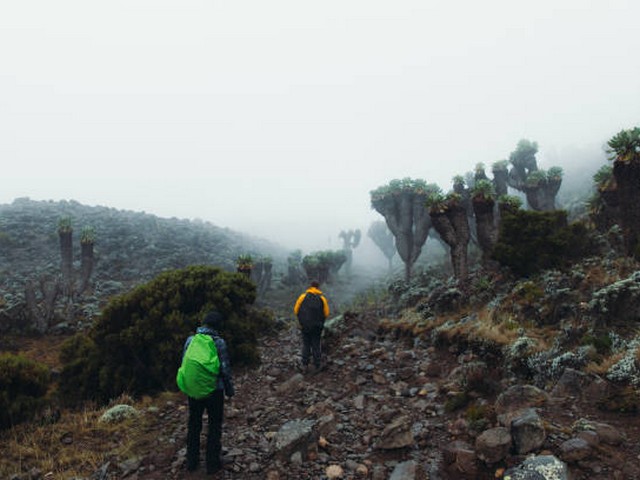How To Stay Safe During Kilimanjaro Trek: Essential Tips from KCTE
As you set your sights on the towering majesty of Mount Kilimanjaro, you’re not just planning a trek; you’re preparing for a life-changing journey. At Kilimanjaro Centre for Trekking and Ecotourism (KCTE), we understand that embarking on such an iconic climb is both exhilarating and daunting. Safety is paramount in transforming this challenge into an inspiring success story. In this guide, we’ll equip you with essential safety tips and practices to ensure that your adventure is as secure as it is unforgettable.
Prepare Adequately Before Your Trek
Physical Preparation
Climbing Kilimanjaro does not require technical climbing skills, but good physical condition is essential. Begin training at least six months in advance, focusing on cardiovascular fitness, strength training, and hiking. Regularly hiking hills or stairs can be particularly beneficial.
Mental Preparation
Mental stamina is just as crucial as physical fitness. Prepare yourself mentally to handle different weathers, altitudes, and even uncomfortable camp conditions. Visualization and mindfulness exercises can enhance your mental readiness.
Health Check-Up
Visit your doctor for a medical check-up to ensure you’re fit for the climb. Discuss vaccinations, altitude sickness medication, and any personal health concerns. It’s crucial to have medical clearance before attempting to summit Kilimanjaro.
Understanding and Mitigating Altitude Sickness
Altitude sickness is a real concern on Kilimanjaro. As you climb higher, the air becomes thinner, and less oxygen is available.
Know the Symptoms
Be aware of altitude sickness symptoms: headaches, nausea, dizziness, and fatigue. Recognizing these early signs can be crucial in addressing them before they worsen.
Climb Slowly
The mantra "pole pole" (slowly, slowly in Swahili) is essential for acclimatization. A slower ascent increases your body’s ability to adapt to higher altitudes.
Stay Hydrated
Dehydration can exacerbate altitude sickness. Drink at least three to four liters of water daily to help mitigate the effects of high altitude.
Gear and Equipment Checklist
Appropriate Clothing
Layering is key. Prepare for warm days, cold nights, and extreme weather at the summit. Essential items include moisture-wicking base layers, a fleece jacket, a waterproof outer layer, and thermal undergarments for the summit assault.
Footwear
Invest in high-quality, broken-in hiking boots. Blisters and discomfort from inadequate footwear can end a climb early.
Other Essentials
Don’t forget a sleeping bag suitable for low temperatures, a comfortable backpack, a headlamp, sunglasses, and sunscreen. Consider trekking poles for additional stability and support.
Travel with the Right Team
Choose Experienced Guides
KCTE prides itself on our experienced, knowledgeable, and certified guides. Our teams are equipped with essential medical training and deep understanding of the mountain’s challenges.
Porter Welfare
Ensuring the welfare of all team members, including porters, is crucial for a safe and successful trek. KCTE adheres to KPAP (Kilimanjaro Porters Assistance Project) guidelines, ensuring fair wages and proper treatment for our porters.
Respect the Mountain
Environmental Awareness
Keep Kilimanjaro clean by adhering to the Leave No Trace principles. Carry all your rubbish down the mountain, including organic waste.
Listen to Your Body and Your Guides
Always communicate any health issues immediately to your guide. They are trained to make crucial decisions that prioritize your safety.
Embrace the Journey
While the goal may be to reach the summit, remember to embrace every moment of your trek. The landscapes, the people you meet, the challenges you overcome, and the stories you’ll tell are what make this trek truly memorable.
FAQs: Safety on Kilimanjaro
How do I prevent altitude sickness?
Prevent altitude sickness by acclimatizing properly ("pole pole"), staying hydrated, eating well, and using medication if prescribed by your doctor.
What is the best time of year to climb Kilimanjaro?
The best times are during the dry seasons: January to mid-March and June to October. These periods offer the most favorable weather conditions for climbing.
Can solo travelers join a group?
Absolutely! KCTE offers group climbs where solo travelers can join others. It’s a great way to meet new friends and reduce costs.
How many days are recommended for climbing Kilimanjaro?
We recommend a minimum of seven days to allow adequate time for acclimatization. Longer routes also have higher success rates.
What should I do if I experience severe altitude sickness?
Descend immediately if symptoms are severe or worsening. Safety is more important than summiting. Our guides can assist in making the safest decisions.
Conclusion: Your Safe Climb Awaits with KCTE
Climbing Kilimanjaro is an adventure that calls for careful preparation and respect for the natural elements. At Kilimanjaro Centre for Trekking and Ecotourism, we are committed to ensuring your journey is safe, enjoyable, and life-enriching. Safety on Kilimanjaro isn’t just about personal achievement; it’s about creating sustainable and respectful tourism practices that benefit both our clients and the local community.
Ready to take on the roof of Africa? Book your Kilimanjaro climb with KCTE today and take the first step towards a safe and thrilling adventure that you will remember for a lifetime. Let us help you reach the summit with confidence and pride. Join us and discover the spirit of Kilimanjaro!
Feel free to contact us for more information, detailed itineraries, and everything you need to prepare for your Kilimanjaro adventure.




